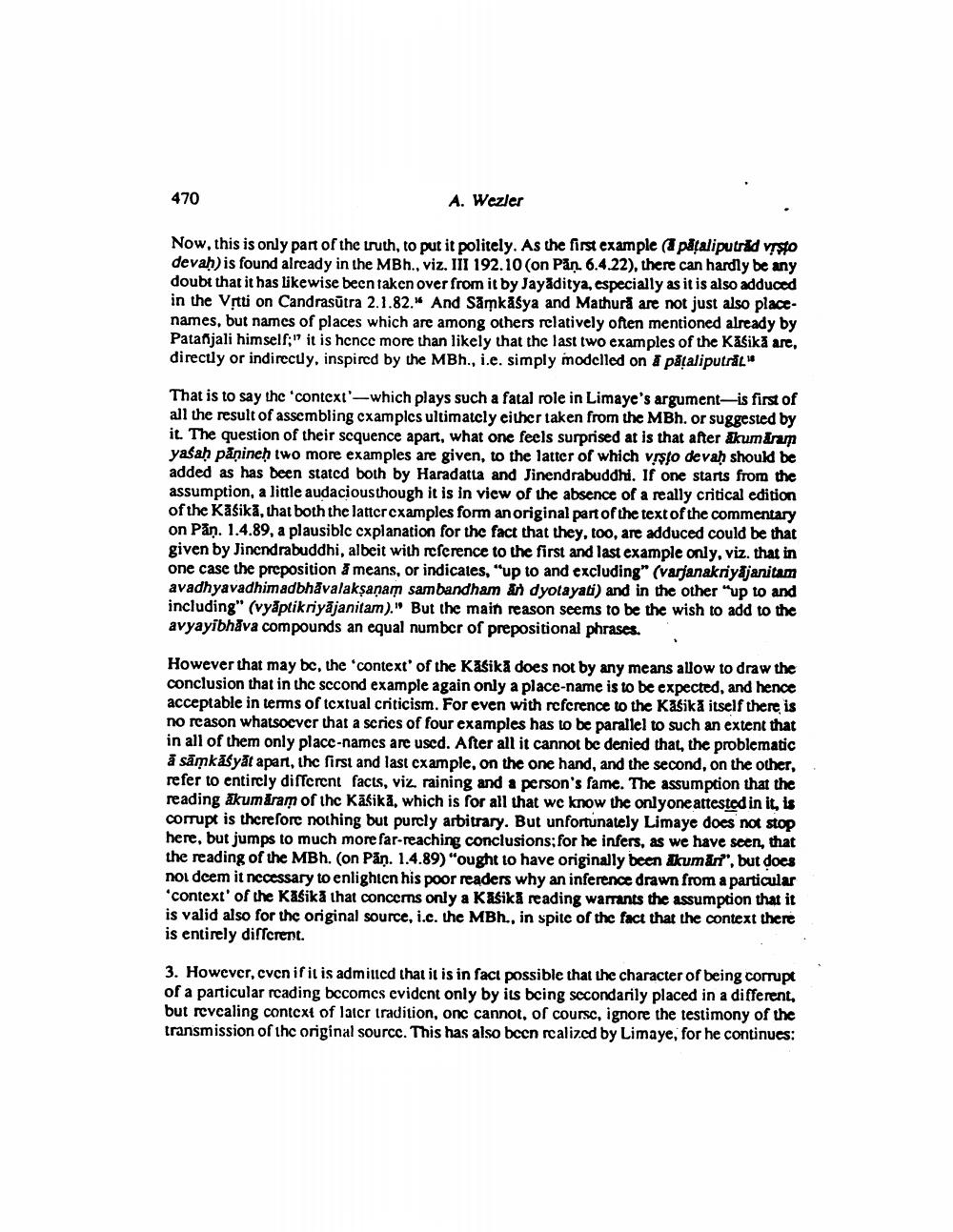Book Title: How Far Did Paninis Fame Really Extend In Patanjalis View Author(s): A Wezler Publisher: A Wezler View full book textPage 3
________________ 470 A. Wezler Now, this is only part of the truth, to put it politely. As the first example (padaliputrid vrsto devah) is found alrcady in the MBh., viz. III 192.10 (on Pan 6.4.22), there can hardly be any doubt that it has likewise been taken over from it by Jayaditya, especially as it is also adduced in the Vrtti on Candrasūtra 2.1.82." And Samkåśya and Mathură are not just also placenames, but names of places which are among others relatively often mentioned already by Patañjali himself," it is hence more than likely that the last two examples of the Kafikā are, directly or indirecuy, inspired by the MBh., i.e. simply modelled on a pataliputráli That is to say the context--which plays such a fatal role in Limaye's argument—is first of all the result of assembling examples ultimately either taken from the MBh. or suggested by it. The question of their sequence apart, what one feels surprised at is that after akumaran yasah panineh two more examples are given, to the latter of which visto devah should be added as has been stated both by Haradatta and Jinendrabuddhi. If one starts from the assumption, a little audaciousthough it is in view of the absence of a really critical edition of the Kašikā, that both the latter examples form an original part of the text of the commentary on Pån. 1.4.89, a plausiblc explanation for the fact that they, too, are adduced could be that given by Jinendrabuddhi, albeit with reference to the first and last example only, viz. that in one case the preposition à means, or indicales, "up to and excluding" (varjanakriyājanitam avadhyavadhimadbhavalaksanam sambandham an dyotayati) and in the other "up to and including" (vyāptikriyājanitam)." But the main reason seems to be the wish to add to the avyayibhāva compounds an equal number of prepositional phrases. However that may be, the context of the Kasikà does not by any means allow to draw the conclusion that in the sccond example again only a place-name is to be expected, and hence acceptable in terms of tcxtual criticism. For even with reference to the Kasikā itself there is no reason whatsoever that a series of four examples has to be parallel to such an extent that in all of them only placc-names are used. After all it cannot be denied that, the problematic ā sākāsyat apart, the first and last example, on the one hand, and the second, on the other, refer to entirely different facts, viz. raining and a person's fame. The assumption that the reading akumăram of thc Käsikā, which is for all that we know the onlyone attested in it, is corrupt is therefore nothing but purcly arbitrary. But unfortunately Limaye does not stop here, but jumps to much more far-reaching conclusions, for he infers, as we have seen, that the reading of the MBh. (on Pån. 1.4.89) "ought to have originally been kuman", but does noi dcem it necessary to enlighten his poor readers why an inference drawn from a particular 'context' of the Kasika that concems only a Kasikā reading warrants the assumption that it is valid also for the original source, i.c. the MBh., in spite of the fact that the context there is entirely different. 3. However, cven if it is admillcd that it is in fact possible that the character of being corrupt of a panicular reading becomes evident only by its being secondarily placed in a different, but revealing context of later tradition, onc cannot, of course, ignore the testimony of the transmission of the original source. This has also been realized by Limaye, for he continues:Page Navigation
1 2 3 4 5 6 7 8 9 10 11
